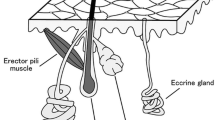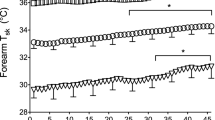Abstract
Natives of the tropics are able to tolerate high ambient temperatures. This results from their long-term residence in hot and often humid tropical climates. This study was designed to compare the peripheral mechanisms of thermal sweating in tropical natives with that of their temperate counterparts. Fifty-five healthy male subjects including 20 native Koreans who live in the temperate Korean climate (Temperate-N) and 35 native tropical Malaysian men that have lived all of their lives in Malaysia (Tropical-N) were enrolled in this study after providing written informed consent to participate. Quantitative sudomotor axon reflex testing after iontophoresis (2 mA for 5 min) with 10% acetylcholine (ACh) was used to determine directly activated (DIR) and axon reflex-mediated (AXR) sweating during ACh iontophoresis. The sweat rate, activated sweat gland density, sweat gland output per single gland activated, and oral and skin temperature changes were measured. The sweat onset time of AXR (nicotinic-receptor-mediated) was 56 s shorter in the Temperate-N than in the Tropical-N subjects (P < 0.0001). The nicotinic-receptor-mediated sweating activity AXR (1), and the muscarinic-receptor-mediated sweating activity DIR, in terms of sweat volume, were 103% and 59% higher in the Temperate-N compared to the Tropical-N subjects (P < 0.0001). The Temperate-N group also had a 17.8% (P < 0.0001) higher active sweat gland density, 35.4% higher sweat output per gland, 0.24°C higher resting oral temperature, and 0.62°C higher resting forearm skin temperature compared to the Tropical-N subjects (P < 0.01). ACh iontophoresis did not influence oral temperature, but increased skin temperature near where the ACh was administered, in both groups. These results suggest that suppressed thermal sweating in the Tropical-N subjects was, at least in part, due to suppressed sweat gland sensitivity to ACh through both recruitment of active sweat glands and the sweat gland output per each gland. This physiological trait guarantees a more economical use of body fluids, thus ensuring more efficient protection against heat stress.






Similar content being viewed by others
References
Bae JS, Lee JB, Matsumoto T, Timothy O, Min YK, Yang HM (2006) Prolonged residence of temperate natives in the tropics produces a suppression of sweating. Pfluegers Arch Eur J Physiol 453:67–72. doi:10.1007/s00424-006-0098-x
Chemali KR, Gorodeski R, Chelimsky TC (2001) Alpha-adrenergic supersensitivity of the sudomotor nerve in complex regional pain syndrome. Ann Neurol 49:453–459. doi:10.1002/ana.94
Chen YW, Elizondo RS (1974) Peripheral modification of thermoregulatory function during heat acclimation. J Appl Physiol 37:367–373
Cheuvront SN, Haymes EM (2001) Ad libitum fluid intakes and thermoregulatory responses of female distance runners in three environments. J Sports Sci 19:845–854. doi:10.1080/026404101753113796
Collins KJ, Weiner JS (1962) Observations on arm-bag suppression of sweating and its relationship to thermal sweating “fatigue”. J Physiol 161:538–556
Fox RH, Jack JW, Kidd DJ, Rosenbaum S (1962) Observations in climatic chambers. Army Personal Research Committee. Medical Research Council, London. Ret No APRC 6:25
Horowitz M (1989) Heat acclimation: a continuum of process. In: Mercer J (ed) Thermal physiology. Elsevier, Amsterdam, pp 445–450
Kondo N, Takano S, Aoki K, Shibasaki M, Tominaga H, Inoue Y (1998) Regional differences in the effect of exercise intensity on thermoregulatory sweating and cutaneous vasodilation. Acta Physiol Scand 164:71–78. doi:10.1046/j.1365-201X.1998.00407.x
Kondo N, Shibasaki M, Aoki K, Koga S, Inoue Y, Crandall CG (2001) Function of human eccrine sweat glands during dynamic exercise and passive heat stress. J Appl Physiol 90:1877–1881
Kuno Y (ed) (1956) Human perspiration. Thomas, Springfield, IL
Leblanc G, Landis SC (1986) Development of choline acetyltransferase activity in the cholinergic sympathetic innervation of sweat glands. J Neurosci 6:260–265
Lee JB, Matsumoto T, Othman T, Kosaka M (1997) Suppression of the sweat gland sensitivity to acetylcholine applied iontophoretically in tropical Africans compared to temperate Japanese. Trop Med 39:111–121
Lee JB, Othman T, Lee JS, Quan FS, Choi JH, Yang HM, Min YK, Matsumoto T, Kosaka M (2002) Sudomotor modifications by acclimatization of stay in temperate Japan of Malaysian native tropical subjects. Jpn J Trop Med Hyg 30:295–299
Lee JB, Bae JS, Shin YO, Kang JC, Matsumoto T, Aliopv AT, Alipov GK, Kim WJ, Min YK, Yang HM (2007) Long-term tropical residency diminishes central sudomotor sensitivities in male subjects. Korean J Physiol Pharmacol 11:233–237
Low PA, Caskey PE, Tuck RR, Fealey RD, Dyck PJ (1983) Quantitative sudomotor axon reflex test in normal and neuropathic subjects. Ann Neurol 14:573–580. doi:10.1002/ana.410140513
Matsumoto T, Kosaka M, Yamauchi M, Tsuchiya K, Ohwatari N, Motomura M, Otomasu K, Yang GJ, Lee JM, Boonayathap U, Praputpittaya C, Yongsiri A (1993) Study on mechanisms of heat acclimatization due to thermal sweating—comparison of heat-tolerance between Japanese and Thai subjects. Trop Med 35:23–34
Matsumoto T, Taimura A, Yamauchi M, Lee J-B, Kosaka M, Pongchaidecha A, Praputpittaya C, Gomonchareonsiri S, Boonayathap U, Sugenoya J (1997) Long-term heat acclimatization in tropical inhabitants. In: Nielsen BJ, Nielsen R (eds) Thermal physiology 1997 abstract. August Krough Institute, Copenhagen, p 69
Morris SJ, Shore AC (1996) Skin blood flow responses to the iontophoresis of acetylcholine and sodium nitroprusside in man: possible mechanism. J Physiol 496:531–542
Nadel ER, Pandolf KB, Roberts MF, Stojwijk JAJ (1974) Mechanisms of thermal acclimation to exercise and heat. J Appl Physiol 37:515–520
Nielsen B (1998) Heat acclimation-mechanisms of adaptation to exercise in the heat. Int J Sports Med Suppl 2:S154–S156. doi:10.1055/s-2007-971984
Ogawa T, Asayama M (1986) Quantitative analysis of the local effect of the skin temperature on sweating. Jpn J Physiol 36:417–422. doi:10.2170/jjphysiol.36.417
Ogawa T, Sugenoya J (1993) Pulsatile sweating and sympathetic sudomotor activity. Jpn J Physiol 43:275–289. doi:10.2170/jjphysiol.43.275
Ogawa T, Asayama M, Miyagawa T (1982) Effects of sweat gland training by repeated local heating. Jpn J Physiol 32:971–981
Onaka S, Hori S, Saito N, Shiraki K, Migasena P, Yoshihara H (1978) The role of food habits in physiological adaptations of inhabitants of Southeast Asia to the habitat of tropical countries. Prog Hum Nutr 2:219–235
Pinnagoda J, Tupker RA, Agner T, Serup J (1990) Guidelines for transepidermal water loss (TEWL) measurement. A report from the Standardization Group of the European Society of Contact Dermatitis. Contact Dermatitis 22:164–178. doi:10.1111/j.1600-0536.1990.tb01553.x
Robinson S, Turrel ES, Belding HS, Hovath SM (1953) Rapid acclimatization to work in hot climates. Am J Physiol 140:168–176
Sato K, Dobson RL (1970) Regional and individual variations in the function of the human eccrine sweat gland. J Invest Dermatol 54:443–449. doi:10.1111/1523-1747.ep12259272
Sato K, Sato F (1983) Individual variations in structure and function of human eccrine sweat gland. Am J Physiol 245:R203–R208
Sato F, Owen M, Matthes R, Sato K, Gisolfi CV (1990) Functional and morphological changes in the eccrine sweat gland with heat acclimation. J Appl Physiol 69:232–236
Sawka MN, Coyle EF (1999) Influence of body water and blood volume on thermoregulation and exercise performance in the heat. Exerc Sport Sci Rev 27:167–218
Sawka MN, Montain SJ, Latzka WA (2001) Hydration effects on thermoregulation and performance in the heat. Comp Biochem Physiol A Mol Integr Physiol 128:679–690. doi:10.1016/S1095-6433(01)00274-4
Shibasaki M, Inoue Y, Kondo N, Iwata A (1997) Thermoregulatory responses of prebubertal boys and young men during moderate exercise. Eur J Appl Physiol 75:212–218. doi:10.1007/s004210050150
Sugenoya J, Ogawa T, Jmai K, Ohnishi N, Natsume K (1995) Cutaneous vasodilatation synchronize with sweat expulsions. Eur J Appl Physiol 71:33–40. doi:10.1007/BF00511230
Taylor NA (1986) Eccrine sweat glands. Adaptations to physical training and heat acclimation. Sports Med 3:387–397. doi:10.2165/00007256-198603030-00003
Tsujita J, Hori S (1978) Comparative studies on sweating reflex, number of active sweat gland and body temperature of subtropical natives and temperate natives. Jpn J Trop Med Hyg 6:157–165
Vilches J, Navarro X, Verdu E (1995) Functional sudomotor responses to cholinergic agonists and antagonists in the mouse. J Auton Nerv Syst 55:105–111. doi:10.1016/0165-1838(95)00033-T
Weihe E, Tao-Cheng JH, Schafer MK, Erickson JD, Eiden LE (1996) Visualization of the vesicular acetylcholine transporter in cholinergic nerve terminals and its targeting to a specific population of small synaptic vesicles. Proc Natl Acad Sci USA 93:3547–3552. doi:10.1073/pnas.93.8.3547
Wilkerson WJ, Young RJ, Melius JM (1986) Investigation of a fatal heatstroke. Am Ind Hyg Assoc J 47:A493–A494, A496
Wyndham CH (1967) Effect of acclimatization on the sweat rate/rectal temperature relationship. J Appl Physiol 22:27–30
Wyndham CH, Strydom NB, Munro A, Macpherson RK, Metz B, Schaff G, Schieber J (1964) Heat reactions of Caucasians in hot dry and hot humid climates. J Appl Physiol 19:607–612
Yoshimura H (1960) Acclimatization to heat and cold. Essential problems in climatic physiology. Nankodo, Kyoto, pp 61–106
Acknowledgments
The authors wish to thank the subjects whose participation made this study possible.
Author information
Authors and Affiliations
Corresponding author
Rights and permissions
About this article
Cite this article
Lee, JB., Bae, JS., Matsumoto, T. et al. Tropical Malaysians and temperate Koreans exhibit significant differences in sweating sensitivity in response to iontophoretically administered acetylcholine. Int J Biometeorol 53, 149–157 (2009). https://doi.org/10.1007/s00484-008-0197-9
Received:
Revised:
Accepted:
Published:
Issue Date:
DOI: https://doi.org/10.1007/s00484-008-0197-9




